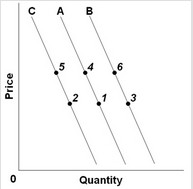A person who prefers a certain payoff over an uncertain one with the same expected value is risk-averse.
Answer the following statement true (T) or false (F)
True
You might also like to view...
Use the figure below to answer the following question. Refer to the three demand curves. An "increase in quantity demanded" caused by a change in price would be illustrated by a change from
Refer to the three demand curves. An "increase in quantity demanded" caused by a change in price would be illustrated by a change from
A. point 2 to point 5. B. point 4 to point 6. C. point 4 to point 1. D. point 5 to point 1.
Which of the following has NOT resulted from more active liability management on the part of banks?
A) increased bank holdings of cash items B) aggressive targeting of goals for asset growth by banks C) increased use of negotiable CDs to raise funds D) an increased proportion of bank assets held in loans
If the initial distribution of two goods between two people is Pareto optimal, which of the following statements is TRUE?
A) It is possible to reallocate the goods between the two people so as to increase the utility of both people. B) It is possible to reallocate the goods between the two people so as to increase the utility of one person without decreasing the utility of the other. C) It is possible to reallocate the goods between the two people so as to increase the utility of one person, but only at the expense of the other person. D) It is impossible to reallocate the goods between the two people so as to increase either person's utility. E) none of the above
Which of the following examples would most likely involve a person earning minimum wage?
a. Fifty-year-old Koki works as marketing specialist for 20 years. b. Twenty-year-old Catherine works as an office assistant for a large corporation. c. Fifteen-year-old Sean works as a caddy while his parents earn $100,000 a year. d. Thirty-year-old Tamar works in a factory while her husband teaches high school.